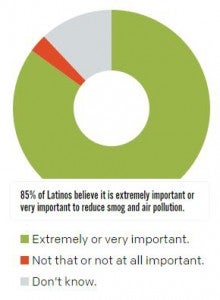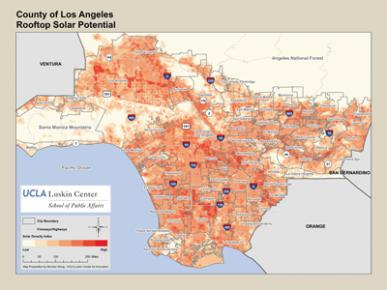 As California’s drive to wean itself from fossil fuels continues, important new challenges are emerging in its wake. Part of a broader effort to shift the state’s electric grid entirely to clean energy by 2045, for example, includes the Los Angeles Department of Water and Power’s recent announcement to retire three gas-fired power plants, while making a series of local investments to manage and balance the electric load. And with the grid getting cleaner, efforts are now getting underway to electrify as many of the other residential, commercial and industrial activities that currently depend on gas.
As California’s drive to wean itself from fossil fuels continues, important new challenges are emerging in its wake. Part of a broader effort to shift the state’s electric grid entirely to clean energy by 2045, for example, includes the Los Angeles Department of Water and Power’s recent announcement to retire three gas-fired power plants, while making a series of local investments to manage and balance the electric load. And with the grid getting cleaner, efforts are now getting underway to electrify as many of the other residential, commercial and industrial activities that currently depend on gas.
Energy Exchange
Selected tag(s): California
The right way for California to divest from natural gas
New Poll: U.S. Latino Communities Overwhelmingly Support Clean Air Protections
 Politicians and political observers are increasing the amount of time spent trying to figure out how to engage with Latino voters – a large and growing part of the American electorate. Issues such as immigration reform usually dominate the discussion nationally, but a new poll from the national polling firm Latino Decisions shows that clean water and healthy air are also of utmost importance for Latinos.
Politicians and political observers are increasing the amount of time spent trying to figure out how to engage with Latino voters – a large and growing part of the American electorate. Issues such as immigration reform usually dominate the discussion nationally, but a new poll from the national polling firm Latino Decisions shows that clean water and healthy air are also of utmost importance for Latinos.
According to their poll 85% of those surveyed found reducing smog and air pollution to be extremely or very important, compared to 80 percent for comprehensive immigration reform.
This comes as no surprise to those of us that are rooted in this community where issues of the health of our communities and families are often top-of-mind around the dinner table. In reality, it also comes as no surprise to decision makers who have listened to our communities, and know Latinos have rich ties to the outdoors, but are too often the first and worst impacted by pollution. Read More
LASER: Turning the climate threat into a story of opportunity for Los Angeles
 This commentary originally appeared on our EDF Voices Blog.
This commentary originally appeared on our EDF Voices Blog.
I’m an L.A. guy, so I like to think about things in epic story lines. And with today’s launch of EDF and UCLA’s Luskin Center for Innovation new “LASER” maps (Los Angeles Solar & Efficiency Report), I think we’ve got a real blockbuster on our hands.
The LASER story opens with a team of top scientists warning us of an imminent threat – climate change – that will cause widespread disruption and human suffering if left unmitigated.
Utilizing the groundbreaking work of Dr. Alex Hall and the UCLA Institute for the Environment and Sustainability, the LASER maps illustrate what climate change is going to look like in the Los Angeles region in just a few decades.
By mid-century, the region will experience a tripling in the number of extreme heat days in the downtown and urban core, and a quadrupling in the number of extreme heat days in the valleys and at high elevations.
The plot thickens as we get a clearer sense of the communities that are most at risk – those already dealing with bad air quality, lack of adequate green space and tree canopy, poor access to public transit, and other challenges like high unemployment levels, poverty and public health hazards.
This is the part of the story where we could give up in the face of seemingly impossible odds…but that’s not how we roll in Los Angeles.
The LASER maps also introduce a powerful narrative about how we can fight back by mitigating the carbon pollution driving climate change, building community resiliency through investments in energy efficiency and renewable energy, and seizing opportunities for economic growth that reduce vulnerability.
Utilizing sophisticated GIS mapping tools and other data, LASER shows the tremendous environmental and economic potential for rooftop solar in Los Angeles County:
- Nearly 29,000 local jobs in solar panel installation could be created if merely 5% of the rooftop solar energy generating potential in LA County was realized.
- If LA rooftops were able to capture that 5% of solar capacity they would reduce carbon dioxide emissions by 1.25 million tons, equivalent to taking 250,000 cars off the road annually.
 Another LASER plot line involves energy efficiency, one of the cheapest ways to reduce carbon pollution and lower utility bills at the same time. The LASER maps show that:
Another LASER plot line involves energy efficiency, one of the cheapest ways to reduce carbon pollution and lower utility bills at the same time. The LASER maps show that:- Nearly 1.5 million buildings in LA County were built before energy efficiency codes went into effect, which means…
- 80% of all buildings in LA County have elevated potential for cost-saving, energy efficiency investments.
If this were actually a Hollywood blockbuster, we would probably cut to a final, climactic showdown and a dramatic rescue from impending doom. But unlike Hollywood, there is no pre-written ending to the climate crisis.
To mitigate the worst effects of climate change, and prepare vulnerable communities for the climate impacts already on their way, we need serious investment and deployment of clean energy and low-carbon infrastructure – particularly in those communities that will be hit the hardest.
LASER provides tools that can help elected officials and advocates pinpoint the communities that are most vulnerable to climate change, identify the region’s clean energy investment potential, and then develop policies and funding mechanism to unleash it. EDF is here to help in that effort, and look forward to supporting our friends and allies in Los Angeles who are working to make the clean energy potential profiled in LASER a real-life success story.
In the end, LASER tells a tale of threat and opportunity in Los Angeles. Now it’s time to get to work to make sure this epic has a positive ending.
At a Key Moment for Energy, California Should Seize Demand Response
 This commentary originally appeared on EDF’s California Dream 2.0 blog.
This commentary originally appeared on EDF’s California Dream 2.0 blog.
Traditionally, if an area’s population grows — or it loses a power plant — it needs more energy. But California and some other states can approach it differently and reduce the use of fossil fuels.
Instead of asking, How can we add more energy?” the real question becomes “How can we reduce demand?”
Two words: Demand Response (DR).
DR is an incentive that has been proven to work on the East Coast and elsewhere, encouraging energy users who voluntarily participate to reduce their electricity usage temporarily when demand could outpace supply.
Recently, the California Energy Commission’s Integrated Energy Policy Report (IEPR) Draft recognized DR as a technology with a high potential to maximize energy efficiency. This report comes at an important time for the state, when greenhouse gas emissions from large facilities have increased in California after decreasing the previous years, in large part due to the closing of the San Onofre Nuclear Generating Station (SONGS) power plant.
In our recently submitted comments, EDF commended the Commission on thinking big on demand response, a cutting edge load management technology that can lower wholesale energy prices when they are highest, dramatically minimize system costs, and reduce air pollution and greenhouse gas emissions.
In their report the Commission also acknowledged that while DR is a great tool if used well, there still “has been little progress towards increasing the amount of DR used in the state.” The Commission included several recommendations to bolster DR going forward, which EDF supports and will advocate for.
We also made suggestions for how the Commission could maximize the use of DR in California, including:
- Encourage customers to enroll in Time of Use pricing
Time of Use (TOU) tariffs allow customers to pay prices for energy that depend on both when and how much they use. By giving customers the option to save money for reducing their energy use at peak times, older, less efficient peaker plants aren’t used as much and the overall system costs go down dramatically. If half of Southern California Edison’s ratepayers adopted its voluntary TOU program, this would replace the need for two thirds of the San Onofre generating capacity.
- Set clear and ambitious goals for demand response in the state
The Commission should set ambitious benchmarks in regard to demand response capacity.
- Foster consumer adoption of innovative demand response technology
Modern technology allows for automated thermostats, ‘set it and forget it’, and other options for easy to use systems that allow interested electricity customers to quickly and consistently respond and reduce energy use when demand is high and the grid is stressed. The Commission should plan to increase consumer uptake of these technologies.
- Support new technologies and quick scaling up of pilot projects
Demand response opportunities exist on a broad scale in California. Innovative ideas like charging electric cars when solar power is abundant to help maximize the benefits from renewables are still being developed. The Commission should encourage and support these new technologies, and look for successful pilots that are both cost-effective and fully scalable.
- Establish effective enforcement mechanisms
By putting in place proper monitoring and enforcement mechanisms, the Commission will help ensure expected environmental benefits.
The Commission’s IEPR is a great step forward, and comes at a key moment for managing California’s energy system. We urge the Commission to continue its work with other stakeholders to increase this momentum, and to utilize its authority – such as appliance and buildings standards and electricity forecasting – to help implement the state’s vision for demand response.
Historic Agreement Demonstrates Broad Commitment To Build Clean Energy Economy
This commentary originally appeared on EDF’s California Dream 2.0 blog.
 With the stroke of a pen, North American efforts to combat climate change and promote clean energy reached a new level today.
With the stroke of a pen, North American efforts to combat climate change and promote clean energy reached a new level today.
I was lucky enough to witness the historic event, as Governor Jerry Brown joined the leaders of Oregon, Washington State and the Canadian province of British Columbia, to sign an agreement that formally aligns climate and clean energy policies in the four jurisdictions.
This signing by these “Fab Four” of the Pacific Coast Collaborative makes sense given all they have in common: they’re geographically connected, share infrastructure, and their combined regional economy accounts for a $2.8 trillion GDP, making it the world’s fifth largest economy.
Keeping It Clean: California Should Use Clean Resources To Integrate Renewables
This commentary originally appeared on EDF’s California Dream 2.0 blog.
 As the 8th largest economy in the world, California remains a global leader in clean tech investment, innovation and adoption of landmark climate and energy policies. What defines our success? Our ability to try things first, set the bar high, and get policies right.
As the 8th largest economy in the world, California remains a global leader in clean tech investment, innovation and adoption of landmark climate and energy policies. What defines our success? Our ability to try things first, set the bar high, and get policies right.
California’s Renewable Portfolio Standard (RPS) is a perfect example of that bold, pioneering spirit. Passed in 2011, the RPS required that 33% of electricity come from renewables by 2020 – a lofty benchmark, even by California’s standards. Along with self-generation and solar rooftop programs, California is successfully adding solar, wind, and other distributed generation to its resource portfolio.
In fact, renewables are successfully becoming a large part of daytime energy production, the California Independent Systems Operator (CAISO) – the organization in charge of balancing the statewide grid – is concerned over how to make up for that energy when the sun goes down while evening energy demand spikes. The question is: How can the CAISO reliably integrate renewables?
The CAISO is currently figuring out how to address this need for “flexible” power and will have a draft decision out on October 2nd. Just like people prefer to take routes they know well when they drive, the CAISO is most comfortable with what they know: familiar fossil fuels. Using clean resources and demand response instead is new territory for them that will require careful orienteering.









